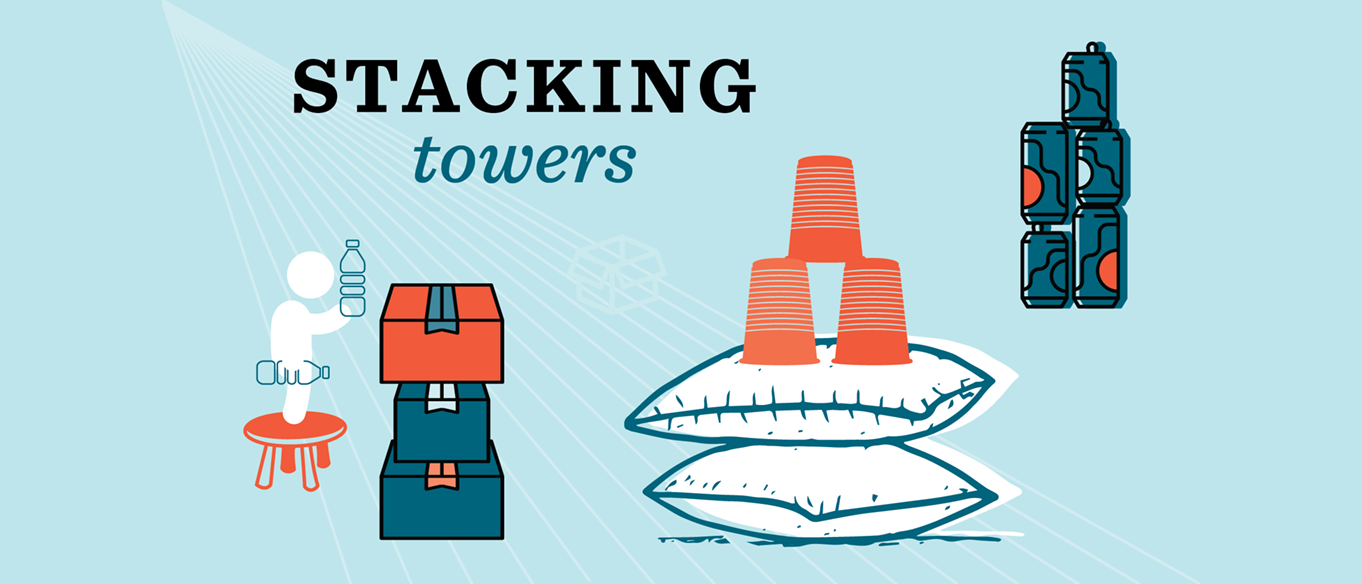
Designing a skyscraper involves choosing the best materials and arranging them in the best way to keep the structure stable as it grows taller and taller. Become a tower-building expert by stacking everyday objects to construct a tower taller than you are!
Age: 4-8
Time: 30 minutes
Topics: stability, balance, engineering design process
What you need:
- Several different types of stackable building materials, such as:
- Wood or foam building blocks
- Plastic or paper cups
- Cardboard boxes
- Soup cans
- Pillows
- Books
- Step stool or chair safe for standing
- Open floor space for tower building
- (Optional) yardstick and/or measuring tape
- (Optional) drawing paper and crayons or markers
What to do:
1. Do some research. Think about what makes a building strong and tall. What kinds of materials are used to build tall buildings? Which shapes or designs have you seen? Look outside, in books, or on the internet for pictures of tall buildings.
2. Look at the building materials you collected. Think about how to build the tallest tower you can, using only one kind of material. Start by making some predictions about what you think will happen:
- Which material do you think will be best for making tall towers?
- What shape of tower will be best for making it strong and tall? Why do you think that?
- How many blocks (or cups or cans) tall do you think the tower will get?
3. Try building different shapes of tower with the same material. Which shape gets tall the fastest? Which shape is hardest to knock over?
4. Next, try building with different types of building materials and see which one gets the tallest. Find a way to compare the different towers by measuring how tall they are. You could use a yardstick or measuring tape to measure them. You could also measure by comparing to another object or part of your own body (for example “ten soup-cans tall” or “as tall as my knee”). Or, you could just build them next to each other and look at them to see which is the tallest. Which material made the tallest tower?
5. Now it’s time to become an expert tower builder and design a tower that is taller than you are! Decide what shape and material will make the tallest tower. You might want to make a plan by drawing what your tower will look like on paper before you build. Remember to use a step stool or chair safely if your tower grows too tall to reach easily!
6. Decide how you will know if your tower is taller than you. You might want to ask another person to help you measure and compare it to you.
7. If your first tower idea doesn’t work, keep trying! Engineers often have to try many times before they find the best solution. Think or talk about questions like these while you work:
- What do you think makes your tower strong?
- What patterns do you notice in your tower? How do you think the pattern helps make the tower tall?
- Which part was the trickiest to build? Why do you think so?
8. Other ideas to try:
- Try to build the tower as tall as the tallest person in your home.
- Build a tower using at least two different kinds of materials together. How does it compare to your other towers?
- Build a tower with a part that sticks out or balances in an interesting way.
- Build a tower that withstands the “wind test”: use an electric fan to blow wind at the tower, or fan it with a large book or other flat object, and see if the tower stays standing.
What’s happening?
In order to stay standing, structures like skyscrapers have to be built so that they resist the pull of gravity. Certain designs make structures stronger and more stable. Triangles distribute forces and help create stable structures. Overlapping blocks rather than stacking them directly on top of one another increases stability. Structures also need to be balanced. They must have a strong foundation and a relatively low center of gravity, so they don’t collapse or tip easily.
When designing tall buildings, engineers use the engineering design process:
- Research – Find out what other people have already made or discovered related to the item.
- Gather requirements – List all the things the new item needs to have, be, or do in order to work correctly.
- Brainstorm and plan – think of lots of different design ideas and then choose the best one.
- Build and test – make a first version of the item and test it.
- Redesign and retest – keep changing, testing, and improving the design until it meets all the requirements as well as it possibly can.

